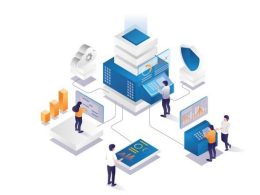eLearning is a very exciting new way to learn. It has the potential to transform education, and it’s already bringing transformative benefits to students across the globe. The e-learning market is growing at a CAGR of 17.54% between 2022-2030.
In this post, we’ll look at how eLearning improves learning outcomes for students and what future trends may bring us even further along this path of enlightenment.
The Rise of eLearning
Several factors, including the growth of online education and mobile learning, have fueled the rise of eLearning. Mobile devices have enabled people to access information anywhere, anytime. The increasing number of mobile users further accelerates this. According to Statista, there were 298 million smartphone users in 2021 in the US, and numbers are increasing daily.
To top it, virtual reality (VR) allows users to immerse themselves in a virtual world where they can interact with objects and environments like never before. This immersive technology also helps students remember things better. Research shows learners feel 40% more confident when learning via VR.
Additionally, augmented reality (AR) lets users see digital images superimposed over real-world scenes through smartphone cameras or tablets. It’s becoming increasingly popular as an educational tool because it provides learners with context while allowing flexibility when interacting with content or researching topics that interest them most.
Advantages of eLearning for Students
eLearning is flexible, so you can learn at your own pace and at any time. It is convenient because no travel expenses are involved when taking an online course. There are many benefits of online courses.
1. Diverse Learning Resources
Diverse learning resources are available online and can be used to supplement traditional classroom learning. They can also be used to learn new skills and knowledge in a more personalized way. For example, students may wish to use a particular website or application as part of their coursework, but they may not have access at school or home because firewalls or filters block it.
With eLearning platforms that allow users access from anywhere with an Internet connection, learners can choose how they want their coursework done. Moreover, students can enroll in online courses to improve their skills and earn degrees.
You will easily find hundreds of such online universities offering online college programs across different fields. For instance, you can find online college programs for bachelor’s, master’s, and even doctorate degrees. These programs can help you learn the right skills, enhance your career, and become a leader.
According to Spalding University, today’s modern business world requires effective leaders who follow the proper ethics. And these online programs can help you become such a leader. Becoming an ethical, effective leader can make a worldwide impact and improve society.
2. Personalized Learning Experience
Personalized learning experiences are more effective than non-personalized learning experiences, and eLearning can provide a customized learning experience for students not in a classroom. Teachers can use eLearning to create content uniquely suited to each student’s needs, interests, and skill level.
In addition to providing an individualized curriculum for each student in their class, teachers also have access to data about how well their students understand the material. When teachers see an issue with comprehension or retention of information, they can adjust their teaching methods accordingly and quickly. Simpler pieces of technology, such as voice amplifiers available from TechXpress here, can also help to provide clearer communication and a smoother learning experience.
3. Enhanced Engagement and Interactivity
One of the most fundamental ways eLearning can improve engagement is through interactivity. It’s one thing to read a textbook or watch a video; it’s another thing to be able to click on something, listen to audio clips, and see animations.
Interactivity is simply the ability for users to interact with content somehow. Clicking buttons, entering text into fields, or dragging objects around the screen are all examples of interaction within digital media.
For example, if you were reading this article on paper rather than online, there would be no way to share it with others or leave comments on specific sections without printing copies of each page individually.
4. Skill Development and Future Readiness
eLearning provides a platform for students to develop skills essential for future success. Students learn to work independently, manage their time effectively, collaborate, and complete tasks efficiently. These skills prepare students for college or the workplace after graduation.
eLearning also allows students to explore their interests and discover new ones by providing opportunities outside of the classroom where they can apply what they’ve learned in real-world situations through projects or internships. This helps develop critical thinking skills, leadership qualities, and entrepreneurial spirit among young people today who will eventually become tomorrow’s leaders in society.
5. Overcoming Challenges and Ensuring Success
In addition to the technology and tools, many factors can contribute to student success. A good teacher is one of them. Teachers have been an integral part of education since its inception. Still, they’re not always enough, especially when students struggle with learning disabilities or other barriers that make it difficult for them to succeed in traditional classrooms.
Costs are also a significant problem in education. However, eLearning can solve it, as online courses usually target a specific skill and cost less. Online courses also help reduce any additional costs. For instance, it can minimize meal costs. Data shows that students supposedly pay $563 more for meals during in-person sessions than when they study from home.
Future Trends and Possibilities
The future of learning is an exciting one. The possibilities are endless, and they all have the power to benefit us in ways we can’t even imagine yet.
The future of education will be shaped by technology and its applications in the classroom. As more people become accustomed to using digital tools at home or work, they will expect these same technologies in their classrooms. Moreover, you can do instructor led training to help students learn remotely.
This expectation may lead educators and administrators toward adopting new methods incorporating technology into their teaching practices and even replacing some traditional techniques entirely. This transition from paper-based materials to electronic ones takes place seamlessly without disrupting student progress or lowering quality standards too much.
Conclusion
eLearning is a powerful tool for students, teachers, and institutions. The benefits of eLearning include increased engagement, better retention, and greater accessibility to learning resources. It’s no wonder that more people than ever before are embracing this technology as an alternative to traditional classroom teaching methods.














